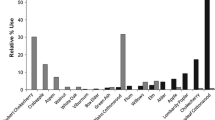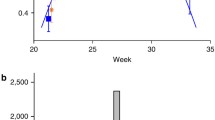Summary
Comparative ecological, physiological and genetic data from two hybridizable predacious species (Chrysopa quadripunctata andC. slossonae) illustrate that host (prey) specificity is based on a broad variety of genetically controlled traits. The array of traits parallels that found in host specific herbivores, and it includes: (i) female choice of oviposition site, (ii) adult dietary requirements for mating, (iii) large egg size, (iv) specialized larval behavior, (v) enhanced larval development, and (vi) univoltinism.
Considerable genetic variation, in both quantitative, polygenically controlled characters, as well as qualitative traits, underlies the differences between the general predator,C. quadripunctata, and the monophagousC. slossonae. The interaction between the predators and their prey is more consistent with the sympatric than the allopatric model of speciation, and theC. quadripunctata/C. slossonae case provides an excellent opportunity for testing various assumptions underlying the sympatric model of speciation.
Similar content being viewed by others
References
Agnew, C. W., Sterling, W. L. and Dean, D. A. (1981) Notes on the Chrysopidae and Hemerobiidae of eastern Texas with keys for their identification.Southwestern Entomol. Suppl. 4, 1–20.
Arthur, A. P. (1981) Host acceptance by parasitoids. InSemiochemicals (D. A. Nordlund, R. L. Jones and W. J. Lewis, eds.) pp. 97–120. Wiley, New York.
Aspöck, H., Aspöck, U. and Hölzel, H. (1980)Die Neuropteren Europas. Goecke & Evers, Krefeld, Germany.
Baker, W. L. (1972) Eastern Forest Insects. U. S. Department of Agriculture Miscellaneous Publication 1175, 1–642.
Begon, M. and Mortimer, M. (1981)Population Ecology, Blackwell, Oxford, UK.
Bush, G. L. (1969) Sympatric host race formation and speciation in frugivorous flies of the genusRhagoletis (Diptera, Tephritidae).Evolution 23, 237–51.
Bush, G. L. (1974) The mechanism of sympatric host race formation in the true fruit flies (Tephritidae). InGenetic Mechanisms of Speciation in Insects (M. J. D. White ed.) pp. 3–23. Australian and New Zealand Book Co., Sydney, Australia.
Bush, G. L. (1975) Modes of animal speciation.Ann. Rev. Ecol. Syst. 6, 339–64.
Colwell, R. K. (1986) Community biology and sexual selection: lessons from hummingbird flower mites. InCommunity Ecology (J. Diamond and T. J. Case, eds.) pp. 406–24. Harper & Row, New York.
Crawley, M. J. (1983)Herbivory. University of California Press, Berkeley, California.
Denno, R. F. and McClure, M. S. (eds.) (1983)Variable Plants and Herbivores in Natural and Managed Systems. Academic Press, New York.
Dethier, V. G. (1954) Evolution of feeding preferences in phytophagous insects.Evolution 8, 33–54.
Ehrlich, P. R. and Raven, P. H. (1964) Butterflies and plants: a study in coevolution.Evolution 18, 586–608.
Eisner, T., Hicks, K., Eisner, M. and Robson, D. S. (1978) “Wolf-in-sheep's clothing” strategy of a predaceous insect larva.Science 199, 790–4.
Evans, E. W. (1982) Timing of reproduction by predatory stinkbugs (Hemiptera: Pentatomidae): patterns and consequences for a generalist and a specialist.Ecology 63, 147–58.
Feeny, P. (1975) Biochemical coevolution between plants and their insect herbivores. InCoevolution of Animals and Plants (L. E. Gilbert and P. H. Raven, eds.) pp. 3–19. University of Texas Press, Austin, Texas.
Feeny, P., Rosenberry, L. and Carter, M. (1983) Chemical aspects of oviposition behavior in butterflies. InHerbivorous Insects (S. Ahmad, ed.) pp. 27–76. Academic Press, New York.
Futuyma, D. J. (1983a) Evolutionary interactions among herbivorous insects and plants. InCoevolution (D. J. Futuyma and M. Slatkin, eds.) pp. 207–31. Sinauer Associates, Sunderland, Massachusetts.
Futuyma, D. J. (1983b) Selective factors in the evolution of host choice by phytophagous insects. InHerbivorous Insects (S. Ahmad, ed.) pp. 227–44. Academic Press, New York.
Futuyma, D. J. and Wasserman, S. S. (1981) Food plant specialization and feeding efficiency in the tent caterpillarsMalacosoma disstria andM. americanum.Entomol. Exp. Appl. 30, 106–10.
Futuyma, D. J. and Peterson (1985) Genetic variation in the use of resources by insects.Ann. Rev. Entomol. 30, 217–38.
Futuyma, D. J., Cort R. P. and van Noordwijk, I. (1984) Adaptation to host plants in the fall cankerworm (Alsophilia pometaria) and its bearing on the evolution of host affiliation in phytophagous insects.Amer. Nat. 123, 287–96.
Greany, P. D. and Hagen, K. S. (1981) Prey selection. InSemiochemicals (D. A. Nordlund, R. L. Jones and W. J. Lewis, eds.) pp. 121–35. Wiley, New York.
Johnson, W. T. and Lyon, H. H. (1976)Insects That Feed on Trees and Shrubs. Cornell University Press, Ithaca, New York.
Karlsson, B. and Wiklund, C. (1985) Egg weight in relation to egg mortality and starvation of newly hatched larvae in some satyrid butterflies.Ecol. Entomol. 10, 205–11.
Kennedy, J. S. (1953) Host plant selection in Aphididae. Intransactions of the IX International Congress on Entomology, Amsterdam, 1951, Vol. 2, pp. 106–10.
Kondrashov, A. S. and Mina, M. V. (1986) Sympatric speciation: when is it possible?Biol. J. Linnean Soc. 27, 201–23.
Lamb, R. J. and Smith, S. M. (1980) Comparison of egg size and related life-history characteristics for two predaceous tree-hole mosquitoes (Toxorhynchites)Can. J. Zool. 58, 2065–70.
Maynard Smith, J. (1966) Sympatric speciation.Amer. Nat. 100, 637–50.
Mayr, E. (1963)Animal Species and Evolution. Belknap Press, Cambridge, Massachusetts.
Mayr, E. (1970)Populations, Species, and Evolution. Harvard University Press, Cambridge, Massachusetts.
Mitter, C. and Futuyma, D. J. (1983) An evolutionary-genetic view of host-plant utilization by insects. InVariable Plants and Herbivores in Natural and Managed Systems (R. F. Denno and M. S. McClure, eds.) pp. 427–59. Academic Press, New York.
Pergande, T. (1912)The Life History of the Alder Blight Aphis. U. S. Department of Agriculture, Bureau of Entomology, Technical Series No. 24. pp. 1–28.
Pimm, S. L. (1979) Sympatric speciation: a simulation model.Biol. J. Linnean Soc. 11, 131–9.
Principi, M. M. and Canard, M. (1984) Feeding habits. InBiology of Chrysopidae (M. Canard, Y. S. Séméria, and T. R. New, eds.) pp. 76–92, Dr. W. Junk, The Hague.
Rice, W. R. (1985) Disruptive selection on habitat preference and the evolution of reproductive isolation: an exploratory experiment.Evolution 39, 645–56.
Rosenzweig, M. L. (1978) Competitive speciation.Biol. J. Linnean Soc. 10, 275–89.
Schultz, J. C. (1983) Impact of variable plant defensive chemistry on susceptibility of insects to natural enemies. InPlant Resistance to Insects (P. A. Hedin, ed.) pp. 37–54. American Chemical Society, Washington, D. C.
Scriber, J. M. (1983) Evolution of feeding specialization, physiological efficiency, and host races in selected Papilionidae and Saturniidae. InVariable Plants and Herbivores in Natural and Managed Systems (R. F. Denno and M. S. McClure, eds.) pp. 373–412. Academic Press, New York.
Scriber, J. M. (1984) Host-plant suitability. InChemical Ecology of Insects (W. J. Bell and R. T. Cardé, eds.) pp. 159–202. Chapman and Hall, New York.
Scriber, J. M. and Feeny, P. P. (1979) The growth of herbivorous caterpillars in relation to degree of feeding specialization and to growth form of their foodplants (Lepidoptera: Papilionidae and Bombycoidea).Ecology 60, 829–50.
Smith, R. C. (1922) The biology of the Chrysopidae. Cornell University Agricultural Experiment Station Memoir58, 1287–1372.
Smith, R. C. (1926) The trash-carrying habit of certain lace wing larvae.Sci. Monthly 23, 265–7.
Southwood, T. R. E. (1973) The insect/plant relationship: an evolutionary perspective.Symp. R. Entomol. Soc. London 6, 3–30.
Strong, D. R., Lawton, J. H. and Southwood, R. (1984)Insects on Plants. Harvard University Press, Cambridge, Massachusetts.
Tauber, M. J., Tauber, C. A. and Masaki, S. (1986)Seasonal Adaptations of Insects. Oxford University Press, New York.
Throne, A. L. (1971) The Neuroptera-suborder Planipennia of Wisconsin. Part 1: Introduction and Chrysopidae.Mich. Entomol. 4, 65–78.
Vinson, S. B. (1976) Host selection by insect parasitoids.Ann. Rev. Entomol. 21, 109–33.
Vinson, S. B. (1981) Habitat location. InSeriochemicals (D. A. Nordlund, R. L. Jones and W. J. Lewis, eds.) pp. 51–77. Wiley, New York.
Vinson, S. B. (1984) Parasitoid-host relationship. InChemical Ecology of Insects (W. J. Bell and R. T. Cardé, eds.) pp. 205–33. Chapman and Hall, New York.
Weseloh, R. M. (1981) Host location by parasitoids. InSemiochemicals (D. A. Nordlund, R. L. Jones and W. J. Lewis, eds.) pp. 79–95. Wiley, New York.
Author information
Authors and Affiliations
Rights and permissions
About this article
Cite this article
Tauber, C.A., Tauber, M.J. Food specificity in predacious insects: a comparative ecophysiological and genetic study. Evol Ecol 1, 175–186 (1987). https://doi.org/10.1007/BF02067399
Issue Date:
DOI: https://doi.org/10.1007/BF02067399




